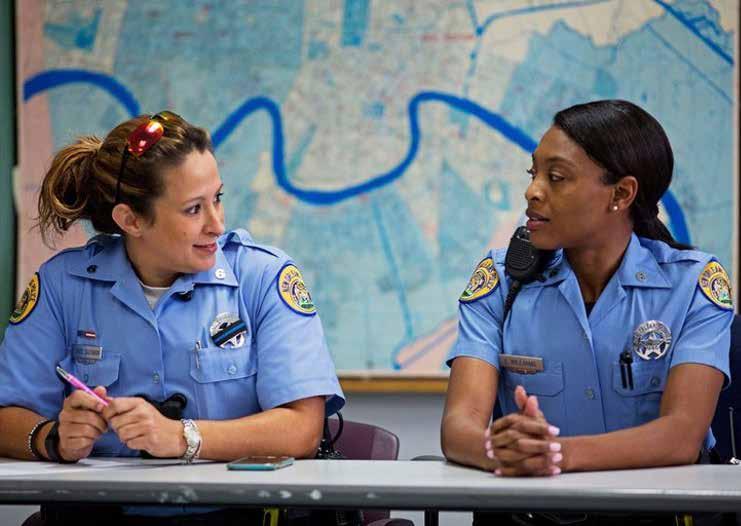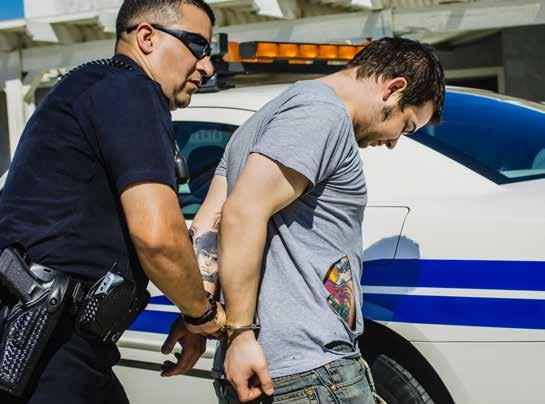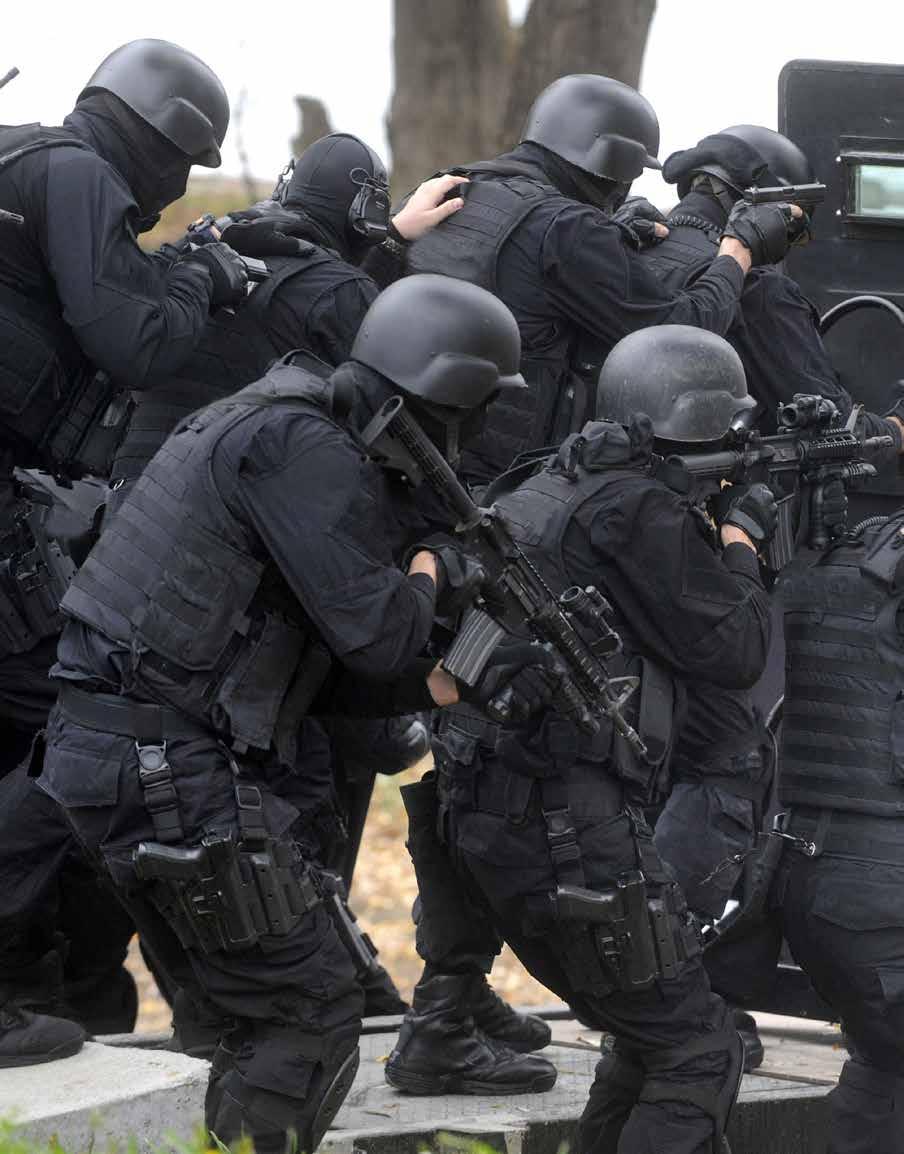
25 minute read
Active Bystandership Can Be Taught and Learned
By: Jonathan Aronie, J.D., and Edward Yeung, M.A.S. This Article originally published in the FBI Law Enforcement Bulletin
Across the country, decision makers at all levels—departmental, local, state, and federal—are taking steps to include “duty to intervene” language in their policies, ordinances, and legislation. However, the law has imposed such a duty upon law enforcement officers for years. According to the U.S. Court of Appeals decades ago, “it is clear that one who is given the badge of authority of a police officer may not ignore the duty imposed by his office and fail to stop other officers who summarily punish a third person in his presence or otherwise within his knowledge.”1 As it turns out, it is not the duty that is lacking but meaningful training on how to perform that duty consistently, safely, and effectively. While it is easy to look at the tragic videos that have gone viral over the past decade and say, “You shouldn’t have to teach an officer to step in and stop that!” intervening in another’s conduct is much harder than it looks in hindsight. The inhibitors to intervention, especially in a hierarchical organization like policing, are strong and pervasive. Fortunately, meaningful training and deliberate practice can help overcome those inhibitors.2 In 2015, the New Orleans, Louisiana, Police Department (NOPD) developed a departmentwide program to do just that. The program, called EPIC (Ethical Policing Is Courageous), is founded upon decades of research (and an early peer intervention program) by renowned psychologist Dr. Ervin Staub.3 Dr. Staub’s and others’ work have demonstrated without question that “active bystandership”—that is, the art and science of intervening in another’s actions—can be taught and learned. Within 2 weeks of the George Floyd killing, more than 100 police agencies across the country had reached out to the developers of the NOPD EPIC Program for help establishing active bystandership programs of their own. It quickly became apparent that NOPD could not meet this overwhelming demand. Enter the Georgetown University Law Center (GULC) and global law firm Sheppard Mullin. Working closely with NOPD, the
Advertisement
Jonathan Aronie, J.D. Edward Yeung, M.A.S.
2 For additional information, see Ervin Staub, The Roots of Goodness and Resistance to Evil: Inclusive Caring, Moral Courage, Altruism Born of Suffering, Active Bystandership, and Heroism (New York, NY: Oxford University Press, 2015);
Ervin Staub, “Preventing Violence and Promoting Active Bystandership and Peace: My Life in
Research and Applications,” Peace and Conflict: Journal of Peace Psychology 24, no. 1 (2018): 95–111, accessed November 10, 2020, https://doi. org/10.1037/pac0000301; and Ervin Staub, “Promoting Healing and Reconciliation in Rwanda, and Generating Active Bystandership by Police to Stop Unnecessary Harm by Fellow Officers,” Perspectives on Psychological Science 14, no. 1 (2019), accessed November 10, 2020, https://doi. org/10.1177/1745691618809384. Mr. Aronie is a partner at Sheppard Mullin L.L.P.; chair of the ABLE Project Board of Advisors; the federal monitor over the New Orleans, Louisiana, Police Department; and a regular guest instructor at the FBI National Academy. Mr. Yeung served as a police officer in New Jersey, retired as an FBI supervisory special agent, and currently is a leadership instructor at the FBI National Academy.
3 See Caroline Modarressy-Tehrani, “The Holocaust
Survivor Hoping to Change American Police
Culture,” NBC News, July 19, 2020, accessed October 28, 2020, https://www.nbcnews.com/news/ us-news/holocaust-survivor-hoping-changeamerican-police-culture-n1234166.

experts who helped create the EPIC Program, and a host of other national thought leaders, GULC and Sheppard Mullin established the Active Bystandership for Law Enforcement (ABLE) Project.4
New Project
The ABLE Project, part of GULC’s Innovative Policing Program, serves as a national hub for bystandership scholarship, resources, and training. Through a series of train-the-trainer events, the ABLE Project will offer bystandership training to law enforcement agencies across the United States. Like the EPIC Program upon which it is based, ABLE training is grounded in evidence and involves a deliberate mix of presentations, thought-provoking discussions, interactive small-group activities, and actual practice. ABLE training also incorporates social science, much of it taken from Dr. Staub’s bystandership experiments in the lab and the field. For example, one unit of the 8-hour training asks officers how they think the inaction of one bystander will impact the willingness of a second bystander to take action in a given event. The experiment used in this unit has nothing to do with policing. It involves an individual (the subject) sitting in a waiting room when he or she hears a loud crash and sounds of distress from the adjoining room, as if someone has fallen from a height and is hurt. This experiment explores whether the subject is more or less likely to enter the adjoining room based on the actions of a stranger (a second person in the waiting room who is a confederate of the experimenter). In one version of the experiment, the stranger does not react to the noise; in the other, the stranger reacts in a meaningful, proactive way. After hearing about the experiment, the officers guess whether the actions of the stranger (i.e., the bystander) will have an impact on the subject. The discussion then feeds into an exploration of the power of bystander police officers on other bystander police officers. It is an engaging and powerful way to see the impact of social science on reallife events.5 Through such interactive projects, officers come face to face with the sociological and psychological inhibitors—like apprehension about making a mistake, fear of being ostracized, obedience to authority, pluralistic ignorance, and others— that keep people from being active bystanders as often as they would like. The officers then learn practical strategies and tactics to overcome those inhibitors; they practice them during facilitated scenario-based role play.
Active Bystandership and Policing Active bystandership training to prevent harm to others is not new. Other professions have used it as a powerful tool for years. The medical profession uses it to teach and empower nurses to intervene to prevent harm caused by inadvertent doctor errors in the operating room.6 The military and the airline industry use it to empower aircraft crews to intervene to prevent pilot error in the cockpit. In the university setting, active bystandership training has helped reduce sexual assault on
4 See Sheppard Mullin, “Joint Project Between
Georgetown University Law Center’s Innovative Policing Program and Sheppard Mullin
Aims to Help Prevent Police Misconduct,” press release, June 15, 2020, accessed October 28, 2020, https://www.sheppardmullin.com/pressrelease-663; and “Active Bystandership for Law
Enforcement (ABLE) Project,” Georgetown Law, accessed October 28, 2020, https://www.law. georgetown.edu/IPP/ABLE. 5 For additional information, see Ervin Staub, “Our
Power as Active Bystanders,” Psychology Today,
January 7, 2012, accessed October 29, 2020, https://www.psychologytoday.com/us/blog/ in-the-garden-good-and-evil/201201/our-poweractive-bystanders. 6 See Jonathan Aronie and Christy E. Lopez, “Keeping Each Other Safe: An Assessment of the Use of Peer Intervention Programs to Prevent Police
Officer Mistakes and Misconduct, Using New
Orleans’ EPIC Program as a Potential National
Model,” Police Quarterly 20, no. 3 (June 2017), accessed October 29, 2020, https://epic.nola.gov/ epic/media/Assets/Aronie-Lopez,-Keeping-Each-
Other-Safe.pdf.

campus.7 Notwithstanding these successes, active bystandership never has been systematically taught to law enforcement officers. To be clear, many academies emphasize the moral and legal obligations to intervene to prevent harm by another officer, but few teach how to intervene effectively. And, fewer still give their officers the opportunity to practice an intervention. This lack of meaningful teaching and deliberate practice has a significant impact on officers’ willingness to use the tools of intervention in the field. It should not surprise anyone to learn that police officers, like other professionals, more likely will use skills they have become familiar with and practiced. Law enforcement agencies know the importance of practice in ensuring that skills and tactics become “muscle memory.” Every officer in the United States has practiced being in a gun fight, although, fortunately, such a scenario is unlikely. This is done so if such a scenario were to unfold, the muscle memory would kick in and the officer hopefully would react smartly and swiftly. However, few officers ever have had the opportunity to practice active bystandership—for instance, telling peers they are making a mistake; saying to a colleague, “I’ll take it from here”; or demanding a senior officer to remove his knee from someone’s neck. But, such training is crucial.
Evidence of Success
While it is hard to quantify the success of an active bystandership program—because when it works, nothing happens—there is no shortage of evidence vouching for its effectiveness. Several examples serve to illustrate. • Decades of research by Dr. Staub and other academics demonstrate that active bystandership can be taught and learned. The research has revealed the universal inhibitors to active bystandership as well as the practical strategies
and tactics for overcoming them. • Many lab and field studies by Dr.
Staub and others have highlighted the power bystanders have over the actions of others. Without question, passivity among bystanders encourages passivity in others, whereas the positive action of one often prompts positive action by others. • The success of active bystandership is demonstrated in other areas, such as hospitals, aircraft, and college campuses. • Survey data documents the not-surprising fact that police officers believe themselves more likely to intervene to prevent harm after participating in active bystandership training.8
7 See Keith Hautala, “’Green Dot’ Effective at
Reducing Sexual Violence,” University of Kentucky
News, September 10, 2014, accessed October 29, 2020, https://uknow.uky.edu/research/green-doteffective-reducing-sexual-violence. 8 See Office of the Consent Decree Monitor, New
Orleans, LA, and Sheppard Mullin Richter &
Hampton, Special Report of the Consent Decree Monitor for the New Orleans Police Department Consent Decree Reporting the Results of the Third Biennial Community Survey, Consent Decree
Monitor Document no. 581-1, November 12, 2019, accessed October 29, 2020, http://nopdconsent. azurewebsites.net/Media/Default/Documents/
Reports/581-1%203rd%20Biennial%20Special%20
Report.pdf.
• It has worked on the ground in
New Orleans.9 Regarding the last bullet, NOPD implemented its EPIC program in 2015 and had most officers trained in 2016. Over the last several years, NOPD has experienced a reduction in police misconduct, uses of excessive force, and citizen complaints. During the same period, it has seen an increase in citizen satisfaction with and respect for the police and in officer job satisfaction.10 While NOPD has undertaken other innovative initiatives that likely have contributed to these encouraging statistics, the EPIC program deserves at least some of the credit. But, as probably the most powerful evidence, those who have been through active bystandership training passionately vouch for its effectiveness. For instance, Baltimore, Maryland, police commissioner Michael Harrison, just one of many who have become vocal proponents, describes active bystandership training as transforming police loyalty from “covering for one another” to “showing loyalty on the front end” by preventing the misconduct or mistake in the first place. According to Commissioner Harrison, active bystandership training “prevents an injury, it saves a broken relationship between police and community, and it saves an officer’s career.”11 Other police leaders speak just as eloquently on the subject.12 A combination of the evidence upon which active bystandership is based coupled with the strong support the training has garnered from both law enforcement leaders and civil rights leaders (the ABLE Project Board of Advisors includes both) prompted the FBI National Academy (NA) to reach out to GULC to explore ways of working together.13 Such a partnership builds upon the NA’s long interest in active bystandership as a means of preventing harm to civilians and police officers. The developers of the NOPD EPIC Program long have been guest instructors at the NA, and NA instructors have presented at NOPD’s annual EPIC Leadership Conference. But, the national demand for quality active bystandership training prompted the NA to take even broader strides in this area. Accordingly, the NA now is working toward incorporating
9 See multiple articles at “Active Bystandership in the News,” Georgetown University Law Center, accessed October 29, 2020, https://www.law. georgetown.edu/innovative-policing-program/ active-bystandership-for-law-enforcement/ active-bystandership-in-the-news/. 10 ee, among other reports, Loyola University New
Orleans School of Law, Path to Reform: Report to Judge Morgan On NOPD Progress Under the
Consent Decree, Consent Decree Monitor Document no. 575, January 2019, accessed October 29, 2020, http://nopdconsent.azurewebsites. net/Media/Default/Documents/Docket%20
Items/575%20Monitor's%20Report%20On%20
NOPD%20Progress%20Under%20The%20Consent%20Decree.pdf.

11 "Duty to Intervene Policies Aim to Prevent Officers from Using Excessive Force,” Robin Young, Here & Now, aired July 20, 2020, on WBUR, accessed
October 29, 2020, https://www.wbur.org/hereandnow/2020/07/20/duty-to-intervene-police-force. 12 See Larry Platt, “An Argument for Funding the Police,” Philadelphia Citizen, July 31, 2020, accessed
October 29, 2020, https://thephiladelphiacitizen. org/danielle-outlaw-policing-plan/. 13 See ”ABLE Board of Advisors,” Georgetown
University Law Center, accessed October 29, 2020, https://www.law.georgetown.edu/innovativepolicing-program/active-bystandership-for-lawenforcement/able-board-of-advisors/. CONTINUED ON NEXT PAGE
ABLE training into the NA’s core curriculum and will partner with the ABLE Project to offer ABLE certification training as an elective to all NA participants. With nearly 1,000 senior police executives from across the United States and the world attending the NA each year, this partnership will help ensure the concepts and pillars of active bystandership spread quickly through the law enforcement community.
Training for Officers
The GULC-Sheppard Mullin ABLE Project is offering a series of trainthe-trainer events, which started in late September 2020. While the training (along with the curriculum, materials, and facilitators’ manuals) is free, participating agencies must commit to 10 ABLE standards. As social activist Ted Quant, a supporter of the ABLE Project, put it during a recent virtual ABLE Project open house, “We don’t want anyone pimping the program for publicity.”14 In short, police agencies not sincerely interested in creating a culture in which active bystandership can thrive need not apply. Among the ABLE Project standards that serve as the “price of entry” for the ABLE train-the-trainer event are 1) a letter from the agency head, 2) a letter from the mayor/ town manager, and 3) two letters from community groups vouching for the department’s sincerity in the program. Other standards include a strong no-retaliation policy, a respectable officer wellness program, and a commitment to “pay it forward”—that is, to go back and train one’s own department and take reasonable efforts to invite a neighboring jurisdiction to the training. when it comes to intervening in another officer’s actions—especially those of a senior officer—to avert mistakes, prevent misconduct, and even to promote officer health and wellness, police officers are no better than anyone else. While we all are active bystanders from time to time, we are passive bystanders far more often than we think. But, decades of research, ingenuous field experiments, and onthe-ground experience all tell us that active bystandership can be taught. The skills of active bystandership can be learned, practiced, and absorbed just like any other skill. Those skills then can be used to do all manner of good, including preventing harm to civilians and officers and fighting against racial injustice, on the street as well as within a law enforcement agency.
14 Ted Quant, comments made during the 3rd
Annual EPIC Police Peer Intervention Executive
Leadership Conference in New Orleans, LA, in
August 2020. The ABLE standards are a small price to pay for entry into an evidencebased program that teaches a life- and career-saving skill. The list of agencies already in line to receive the training is long and prestigious. Examples include the— • Baltimore, Maryland, Police
Department; • Philadelphia, Pennsylvania, Police
Department; • Washington State Criminal Justice
Training Commission; • New Hampshire Police Standards and Training Council; • Northern Virginia Criminal Justice
Training Academy; • Fayetteville, North Carolina, Police
Department; and • Wilmington, North Carolina, Police
Department. The list grows every day, probably because active bystandership training offers so many benefits to agencies, their officers, and their communities.

Conclusion
Police officers are active bystanders in many ways. They put themselves in danger to help others every day. They run toward the gun shots, not away. They show courage when so many others would show fear. Yet,
Endnotes
The Article was originally published in the FBI Law Enforcement Bulletin "Active Bystandership Can Be Taught", by Jonathan Aronie, J.D., and Edward Yeung, M.A.S., 12.08.2020, FBI Law Enforcement Bulletin, https://leb.fbi.gov/articles/featuredarticles/active-bystandership-canbe-taught-and-learned. Reprinted with permission.
Technology Update
By: Christopher J. Braun MSIT, PCPA Technology Coordinator
PAVTN

These new 2021 courses were available on January 1, 2021: 21-001 Legal Update - A mandatory three-hour course highlighting pertinent court decisions and significant pieces of legislation passed after July 1, 2019 that affect police operations and investigations. Lessons will address changes and updates to the Pennsylvania Crimes Code, Vehicle Code, and Rules of Criminal Procedures as well as decisions from Pennsylvania’s Commonwealth, Superior and Supreme Courts, various Federal Courts, and the United States Supreme Court. A final segment of the course will focus on topics such as the issue of excessive charging by police officers and the different jurisdiction and authority of the various law enforcement agencies and officers throughout the Commonwealth. 21-002 Juvenile Justice- A threehour elective course providing a review of the Juvenile Act to include: juvenile custody, placement procedures and options, segregation from adult prisoners, information needed for the juvenile allegation, and the juvenile court process and proceedings. The course will have focused discussions on juveniles in holding and interviewing juveniles. The training will include resource information which is available to the officers for assistance and support. 21-003 Child Victims of Human Trafficking - A three-hour elective course discussing Human Trafficking with a focus on child victims and sex trafficking. The course will teach a Victim Centered Response, as victims are the key to successful investigation and prosecution of sex traffickers, but surviving victims are typically severely traumatized with both immediate and long-term consequences. Lessons will define child sex trafficking, identify who is at risk, explain the consequences of child sex trafficking, and offer suggestions for addressing the expanding problem of child sex trafficking. 21-004 Recognizing and Responding to Individuals with Special Needs - A mandatory three-hour course focusing on timely recognition and appropriate law enforcement response to individuals with special needs. The course will teach officers to employ appropriate communication techniques and de-escalation tactics when interacting with individuals who have special needs or who exhibit behaviors associated with mental illness, intellectual and physical disabilities, and/or autism. The training will include information and instruction for officers regarding available services and support systems for individuals with special needs. It is encouraging to see since January 1, 2021, over 7300 officers have logged on to the PAVTN to start their annual training. While many are taking the two MPOETC electives, there are other interesting electives available, especially on
the topics of STOP violence against women and helping crime victims. However, electives only count the first time you take them and for the calendar year you take them. Occasionally officers take a course that they took several years ago. While that is a great refresher to help them, it will not count as credit again.
Our new Forensic program to help police departments be better equipped and trained to process crime scenes and collect evidence has finally started. The project supports improving the quality and frequency of collected latent evidence from crime scenes across the Commonwealth. Through a sustained effort of training, equipment, and agency executive support, a collaborative enterprise can be substantiated to educate and equip larger police departments, District Attorney Offices, Sheriff Offices, and/or regional partnerships (for the smaller agencies) to employ the latest discovery, collection, preservation, and development tools for processing latent evidence. Since it will be impossible to conduct this training in a classroom for at least six more months or more, we are taking it virtual. The first course “Video Literacy | What Every Investigator & Prosecutor need to know” a 16-hour Online course, February 25, 26 and March 1, 2021 was completely booked in days. We continue to plan how to provide additional training either online or in social distanced classes. Please check our web site and your email for future courses.

Body Worn Camera Grant
Our body worn Camera grant has now help ten police departments deploy 150 body worn cameras. Through the grant these departments received policy and technical advice through the U.S. Department of Justice, Office of Justice Programs, Bureau of Justice Assistance launched the Body-Worn Camera Policy Implementation Program (PIP). For any department that is considering or starting body worn camera program PIP has a web site with a wealth of information, resources, podcasts, and newsletters to assist you. Here is their web site: www. bwctta.com. Using BWCs in police work is a project that requires careful development of policy and deployment. PIP is a resource that has all the experience of those that were the early adopters of this technology and that can be used to help new departments avoid errors.
Mobile Fingerprint Identification Devices

The PCPA Mobile Fingerprint Identification Project is still operating. In the month of January 489 inquiries were made through our 274 deployed devices. This is about half of the number before the pandemic. However, this is a valuable device in the pandemic, for when you have cause to identify someone by fingerprints, you do not have to transport them to a livescan location.
We are now again delivering devices and we are doing the limited in person training according to the COVID guidelines with personal distancing. However, training on the devices is also available on the PAVTN. Hundreds of uses proved the effectiveness of these devices identifying suspects in the field that do not have other identification. In some cases, wanted persons were discovered in others new crimes were both identified and prevented. While the grant funding is gone, there are still a few refurbished devices available for just the annual operating cost of $990. That provides the device, full system/device maintenance and one year of secure cellular service. Any department interested can see the requirements on our web page https://pcpa.memberclicks.net/ mobile-fingerprint-id or contact me by email cjbraun@pachiefs.org.
America’s largest and most experienced law enforcement accreditation consulting company is proud to be working with the Pennsylvania Chiefs of Police Association in bringing our suite of services to the Keystone State. Our holistic business model includes distributing the system, developing customized policies for your department and assisting your agency gather the appropriate proofs of compliance required by the accrediting body. To date, we have directly assisted in excess of one hundred fifty law enforcement agencies succeed in their goal of becoming accredited.

The Rodgers Group is proud to announce our partnership with Chris Boyle Law Enforcement Consulting and our expansion of TRGs Accreditation Consulting, Online InService Training and Policy Writing Services with Law Enforcement Agencies throughout Pennsylvania. Mr. Boyle is a retired Police Lieutenant, licensed attorney, and currently holds a position as a Criminal Justice Instructor at the Temple University Municipal Police Academy. He began his law enforcement career in the Philadelphia Police Department, serving as a Patrol Officer, Detective, Sergeant and Lieutenant in the Patrol, Detective, Narcotics and Training Bureaus. He retired as the Department Advocate in 2005 where he was responsible for the coordination with the Internal Affairs Bureau and adjudication of all disciplinary matters for the 6500 member Department. Since 2005, he has served as a civil rights trial attorney and law enforcement consultant where he routinely reviewed police policies and procedures regarding pursuits, search and seizure, the use of force and other law enforcement topics. He is a contributing editor to The BULLETIN and TRUST CONNECTIONS, the quarterly publication of the Delaware Valley Property and Liability Trust. He is frequently called upon to present seminars and training to law enforcement and the legal profession on topics from liability and defenses, to racial profiling and in-custody deaths. “We are excited to welcome Chris to our team and look forward to the future as we continue our expansion across Pennsylvania and beyond”, said Frank Rodgers, president of The Rodgers Group. “His extensive experience, outstanding reputation and shared vision for assisting the law enforcement community and the public they serve make him a perfect fit for our team.” “The chance to work with Maddie Lewis, Jenn Ruggeri and the rest of the Rodgers Group team is an incredible opportunity to put my thirty-two years of law enforcement experience to use for the betterment of our profession. I see policy, training and accreditation as three of the fundamentals of professional policing, and The Rodgers Group as the perfect partner to work with. Given the experience of Jenn, Maddie and myself working with Pennsylvania Police Departments and municipalities, and The Rodgers Group’s decades-long track record and infrastructure, I see us doing great things together.”
Also leading our growing efforts in Pennsylvania are Officer Madeline Lewis of the Lower Merion Township Police Department and Mrs. Jennifer Ruggeri of the Newtown Township Police Department; both of whom have lead their agencies to PLEAC and CALEA accreditation.
PENNSYLVANIA CHIEFS OF POLICE ASSOCIATION
o Active Membership APPLY ONLINE! $150 per year plus $100 Initiation Fee ($250 to accompany application) o Affiliate Membership $150 per year plus $100 Initiation Fee ($250 to accompany application)
3905 North Front Street | Harrisburg, PA 17110 | Tel: 717-236-1059 | Fax: 717-236-0226 | www.pachiefs.org
¨ CHECK HERE FOR A MAILED COPY OF THE BULLETIN...$25 PER YEAR Please type or print clearly.
APPLICANT INFORMATION
Name ___________________________________________ Rank ___________________________ Date of Appt______ Full Name of Employer ______________________________ Office Address ____________________________________
________________________________________________ County _____________________ Phone _______________ Fax ___________________ Email ____________________
RECOMMENDING MEMBER
Please list a current member of the Pennsylvania Chiefs of Police Association who has recommended that you apply for membership. If the applicant holds a rank lower than
Chief, your recommending member must be your Chief, Superintendent or Commissioner.
Recommending Member Name and Title:
Are you a sworn police officer? Y or N Full time police officer in above department? Y or N MPOETC # ________________________________________ If not applicable, please explain why MPOETC number is not present __________________________________________
Residence Address ________________________________
________________________________________________ County ____________________ Region _______________ Date of Birth _______________ Phone ________________ Have you ever been convicted by a Court of Record of the commission of a felony or misdemeanor? Y or N If yes, explain on a separate sheet of paper and attach to application form. Signature of Applicant: Department Name and Phone Number:
APPLICANT DEPARTMENT INFORMATION
Provide the number of sworn police officers in your department Full time ___________ Part time __________
If industry, number of security officers under applicant’s command ___________
If other, state nature of business in relation to law enforcement
MAIL TOTAL FEE AND THIS FORM TO:
PA Chiefs of Police Association 3905 North Front Street, Harrisburg, PA 17110
MEMBERSHIP QUALIFICATIONS
Section 4. Active Membership. “Active” membership shall be open to the following: (a) All full-time sworn chiefs of police, superintendents, or commissioners of municipal police agencies in the Commonwealth of Pennsylvania who have police powers and MPOETC Certification (b) All full-time sworn municipal police officers in the Commonwealth of Pennsylvania who have police powers, MPOETC Certification and hold the rank of captain or above and persons who hold the rank of Captain or above that are members of the Pennsylvania State Police; (c) Special agents in charge, assistant special agents in charge, and resident agents of any law enforcement entity of the United States government if, at the time of application, such persons are headquartered in the Commonwealth of Pennsylvania; and; full-time persons with command-level responsibility in any law enforcement agency of the Commonwealth of Pennsylvania provided that these individuals are not elected to their position by a popular vote of citizens Section 5. Affiliate Membership. “Affiliate” membership shall be open to those persons who, by occupation are Chiefs of Police who work part time, Police Officers In Charge of Police Departments, Directors of Police Agencies, and Ranking officers who have a supervisory role in a police department. This category also includes agency heads of Corporate Security and Police Academies . These individuals must share a mutuality of interests with the Association and its membership, enabling them access to information from the Association that is regularly provided to Active Members. Affiliate members may attend the Association’s Annual Meeting at the invitation of the Executive Board and under no circumstances shall such members have or exercise the privilege of voting, either by voice or ballot, on Association business. For the full by-laws regarding membership, please visit our website at www.pachiefs.org.

When storage is more than just a solution.
Datum’s line of heavy-duty steel weapon racks and lockers offer the customizable, secure storage you need when readiness and efficiency matter most.
• Durable, heavy-duty steel construction • Customizable to weapons, gear, and evidence • Made in the USA since 1968 • Exclusive Lifetime Product Warranty

PROUD SPONSOR

Most training is good training; however, training developed specifically for YOUR Department and training that reflects YOUR policies and YOUR values is what separates most training from great training; it’s what separates good departments from great departments. At The Rodgers Group (TRG), this is the standard we hold ourselves to, and the standard your Department will be held to.
Every year, departments spend thousands of dollars on cookie cutter training that results in little to no performance improvement. Training by The Rodgers Group is developed specifically for your agency by MPOETC-certified instructors to withstand the rigors of an academic review and ensure a demonstrated knowledge transfer. Our trainings are delivered to your agency through your Department’s site, which means it can be completed any time, reducing training expenses and enhancing scheduling flexibility.






